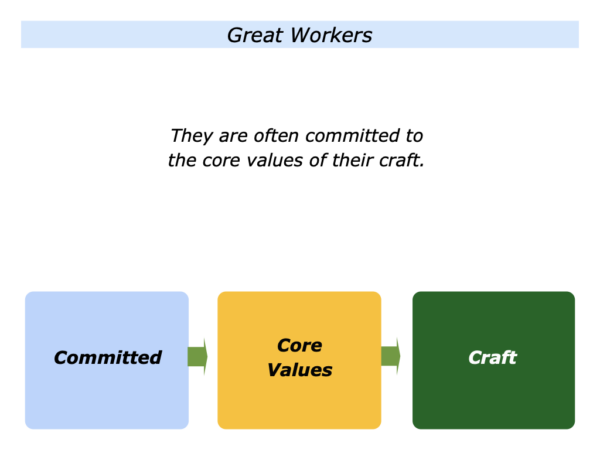
Great workers are often committed to the core values of their craft. They believe in following these values when pursuing their vocation. They aim to translate these values into action when working in education, medicine, technology, science or other fields.
Such workers have a strong sense of integrity. They put their professional values first and follow these to perform superb work. They have difficulty if asked to compromise these values when working for an organisation or company.
I came across this dilemma when running leadership courses for forensic scientists in the UK during the 1990s. The scientists did in-depth work on crimes that could lead to prosecution. They prided themselves on the quality and accuracy of their work.
Politicians then decided that the scientists must become a government agency and compete with private suppliers. This compromised their ethical standards.
The lead scientist in the service explained the dilemma that he and his colleagues faced. He summarised this in the following way.
It takes time to visit the crime scene, collect evidence and investigate it properly. We then need to produce a report that is ethically and scientifically sound.
The service is already stretched for resources. I am sure every service says the same, but it needs significant funding to update equipment, keep its best people and maintain high standards.
The government have told us that the police now want our reports in half the time and want to speed up the prosecution process. If we do not take this step, then our services will be outsourced to private suppliers.
We want to improve, but not at the cost of providing unsafe evidence that could determine people’s lives. The government wants to save money, but this could lead to unsafe convictions. It could also lead to our best scientists leaving the country to work abroad.
Looking at your own life, can you recall when you followed certain values when pursuing a craft? You may have encouraging people, nurturing a garden, renovating a house, running a sport club, leading a project or doing a particular piece of work.
Looking back, what were the values you aimed to follow? How did you translate these values into action? What happened as a result of taking these steps?
If you wish, try tackling the exercise on this theme. This invites you to describe a time in your life when you chose to pursue a particular craft. It then invites you to do the following things.
Describe the core values you aimed to follow when pursuing this craft.
Describe the specific things you did to follow these core values when pursuing the craft.
Describe the specific things that happened as a result of taking these steps.
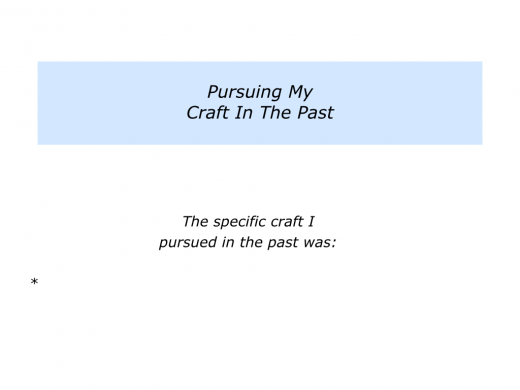
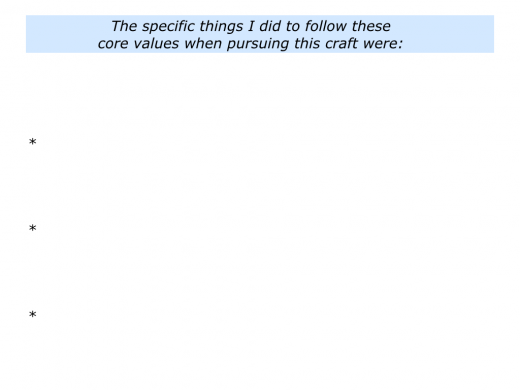
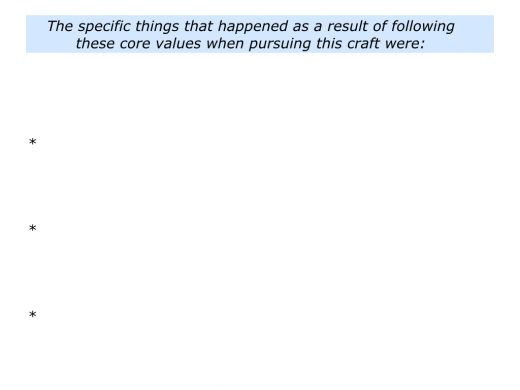
During the past 50 years I have worked with many people who believed in being loyal to their values. One person put it in the following way.
“I am ready to stand or fall by doing what I believe in. If I succeed, that is great. If I don’t, then at least I have still been true to my values.
“If I am not true to my values, then I have failed twice. I have failed by not doing what I believe in and also by failing to achieve the goals.
“I am realistic and do my due diligence. I aim to do work where I can be true to my values and also stand a reasonable chance of success.“
Anita Roddick was somebody who followed her values. She acted as a role model for people who wanted to build ethical and successful businesses.
At the same time, she was also prepared to introduce a different vocabulary into business. Whilst it was important that The Body Shop was profitable, she also talked about different definitions of success.
Anita may have come across as an idealist, but she was remarkably savvy. She learned the ‘Can Do’ attitude from her Italian parents. They ran an American-style Diner café in in Littlehampton, Sussex, during the 1950s.
Opening the café at 5.00 am to cater for the fishermen’s breakfast, they kept serving throughout the day until the last customer was satisfied. Anita served in the café from an early age and felt what it was like to handle money.
Gilly Mckay and Alison Cork take up the story in their book The Body Shop. Anita explained to them how her apprenticeship proved invaluable when starting the first shop in 1976.
When I opened the doors, I was not thinking about changing the world. I simply had to take £1000 in the first week to feed the baby and pay the bills.
With £4000 borrowed from the bank I could only afford to spend £700 on products. But the 20 products we formulated looked pretty pathetic all standing on one shelf.
So to make the shop look busy and full I produced them in five sizes of bottles. I couldn’t afford fancy packaging so I bought the cheapest bottles available and the labels were handwritten.
We painted the ceiling of our tiny shop green to cover the damp patches and put garden fencing on the walls to stop rain splashing the products.
The first day we opened was a Saturday and we took £100. The other retailers in the street were laying odds of 10-1 against our surviving six months, but we were on our way.
Anita was extremely down-to-earth. She used her gifts to run a successful business and also support other pioneers.
Below is a video of Anita talking about the importance of fun and story telling when running The Body Shop. You can discover more via the following link to The Roddick Foundation.
http://www.theroddickfoundation.org/
Professionals can sometimes find themselves in a dilemma when asked to carry out orders that conflict with their values. Here are some of the options they have.
They can carry out the orders and go against their values;
They can stay true to their values and leave the organisation;
They can go to their stakeholders and outline the potential options for going forwards, together with the pluses and minuses of each option.
The lead scientist I mentioned earlier chose the latter route. Meeting with the civil servant in charge of the shift to agency status, he explained the situation in the following way. This is a summary of the messages he gave.
We want to keep improving and are ready to implement the change to agency status.
The minister obviously has targets regarding when the change needs to happen. At the same time, however, they will recognise it is important to do this successfully and also retain our best scientists.
Looking at the way forward, there are at least two routes we can follow. There may be other options, of course, which is why I would like your views. Here are the two obvious options.
a) To work with selected laboratories to build successful prototypes that show the model works.
The pluses are these. The successful models will provide evidence that the approach works; the scientists are then more likely to adopt the approach; the prototypes give us chance to learn and build on what works; the police in some areas will get their reports earlier; the minister will be able to say we are following scientific methods that will enable us to lead the world.
The potential minuses are these. The timetable for overhauling the complete service may take longer; the police in some areas may get impatient, seeing colleagues elsewhere getting reports earlier; the minister may get unhappy about the full implementation being delayed.
b) To ask each of the present laboratories to make all the changes by the date that has been given – the end of the present financial year.
The pluses are these. The changes will get done, at least on paper; the police will get their reports quicker; the minister will meet their target.
The potential minuses are these. The scientists will feel railroaded; the implementation may be patchy; the quality of work may be compromised; the staff morale may suffer, because they like to be involved in finding ways to improve the service.
As I said, there may be other options. Looking at these and other potential way forward, which route would you like us to follow?
The civil servant was polite. At the same time, however, she outlined the pressures from above.
She recognised that the first option of showing proof of concept was attractive to the scientists. Because of the time schedule however, she doubted whether it would appeal to the minister. Nevertheless, she promised to see what might be possible.
The message came back that: a) the timetable was not up for negotiation; b) the service was expected to deliver world-class standards on a tighter budget.
The lead scientist reflected on the decision. After some thought, he decided to stay on to ensure all the laboratories got support in making the changes. He did this because of loyalty to the staff and to, as far as possible, protect the quality standards.
Even though it involved much extra work, he also gave special attention to three laboratories. The lead scientist believed that these could do pioneering work in forensic science.
The forensic service eventually became an agency. It did some excellent work whilst, on some occasions, becoming involved in controversy.
Many of the original staff left within the first few years. The lead scientist also moved on, though he was satisfied with the work he did during the transition. He accepted an offer from a competitor that gave him the chance to return to his specialism.
The agency came under increasing pressure from the private sector, competitive tendering and the drive towards outsourcing. These factors eventually led to its closure.
Let’s return to your own life and work. Looking ahead, can you think of a particular craft you may want to pursue? What may be the values you want to follow? How can you translate these into action?
If you wish, try tackling the exercise on this theme. This invites you to describe the craft you may want to pursue. It then invites you to do the following things.
Describe the specific core values you may aim to follow when pursuing this craft.
Describe the specific things you can do to follow these core values when pursuing the craft.
Describe the specific things that may happen as a result of taking these steps.
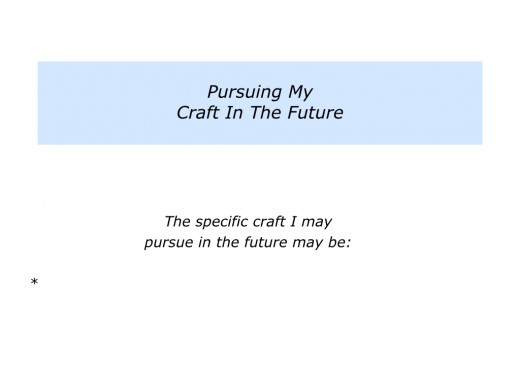
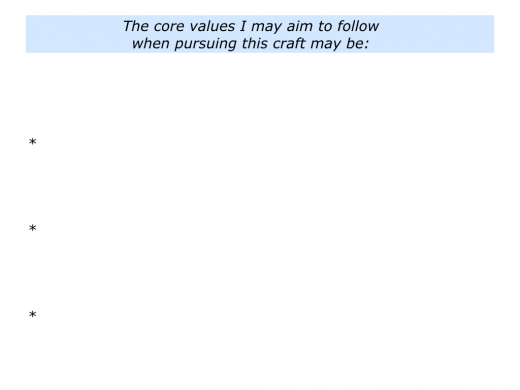
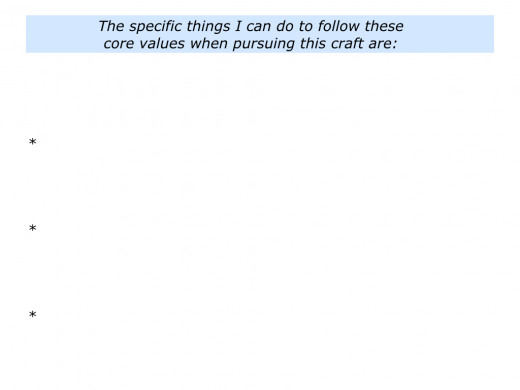
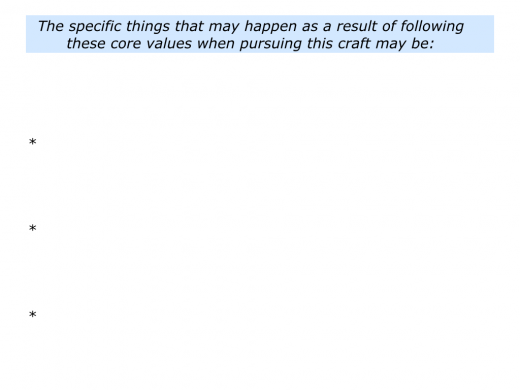






Leave a Reply